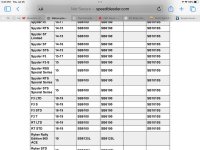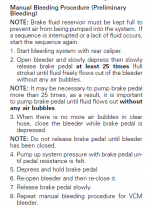The part that makes speed bleeders so nice is not having to open and close the bleeder with each pump of the pedal.
But I did not open an close the bleeder, just left it open and it bled just fine.
OK, so you open the bleeder, pumped the brakes, and all is well? Did any brake fluid come out?
Yes, I bled a couple ounces.
The thing to be concerned about if you bleed
without closing off the bleed valve or using Speed Bleeders/at least a check valve is
not so much the amount of that comes OUT, it's the significant risk of what might be, or in reality - is probably going back IN!! :gaah: nojoke
Every time you lift off the pedal without closing off that bleed valve to stop it sucking any crap back in is a risk - it
might be just sucking back a small amount of ejected brake fluid, but it
could be sucking back some air, or
very likely all of the above plus some further contaminated fluid (did you wash whatever you used to catch the ejected fluid with water or a solvent of some sort? Did you dry it in an oven, not just give it a wipe? Did you then make sure it was sealed to stop letting any humid air get in??)
Even just high humidity air can contaminate your brake fluid, that's one of the reasons you need to flush & change the brake fluid regularly - brake fluid absorbs moisture from the air, and over time, that moisture contamination spreads out thru the brake fluid in the system, potentially causing rust & other internal issues, but more worryingly, gradually contaminating the fluid right down to the caliper - where, once the brakes are used and the non-compressible & very hard to boil brake fluid gets hot, the also non-compressible and not so hard to boil water/moisture in the fluid will also get hot... potentially boiling said water, which turns to steam! Only steam
IS compressible, and now you've got compromised brakes!! And even non-humid air is compressible, plus, it encourages and enhances corrosion, especially in a warm & wet environment, like inside your brake system... :banghead:
So, by not using a check valve or closing off that bleed valve before the pressure comes off the brake pedal, you've almost certainly introduced
some contaminants if not
actually moisture/water contaminated brake fluid RIGHT AT THE VERY WORST PLACE YOU COULD POSSIBLY EVER ADD CONTAMINANTS!! :yikes: Sure, it's
probably not
too contaminated, and it
probably will 'dilute' a bit more in the rest of the good brake fluid still in the system - but this is a critical part of your brakes, a major safety concern, and even a
miniscule amount of 'water' in there can cause brake fade &/or failure when you least need/want it to occur; or it could start the caliper piston &/or cylinder rusting; or cause them/something else to seize... any/all if which can cause brake fade &/or failure when you least need/want it to occur!! So I guess it comes back to how lucky do you feel?? And how comfortable you are with putting every other road user around you &/or pedestrian/innocent by-stander you pass at risk?? :dontknow:
So I'd
STRONGLY recommend that you bleed your brakes properly, closing the bleed valve off before releasing the pedal each time; or use something like Speed Bleeders or a check valve to ensure that you aren't sucking contaminated brake fluid &/or anything else into your brake system while you're bleeding them!! :lecturef_smilie:
Just Sayin'!



